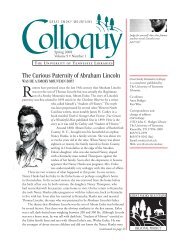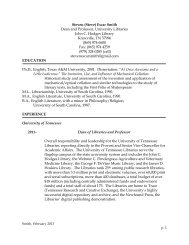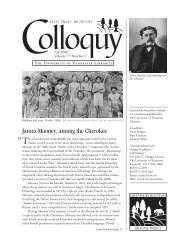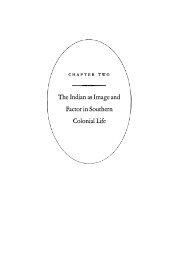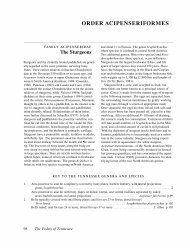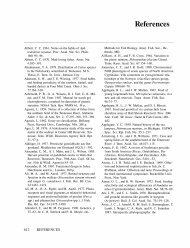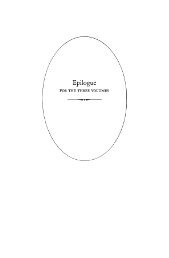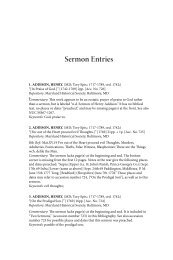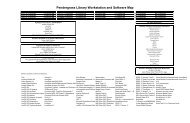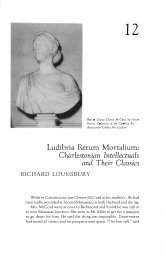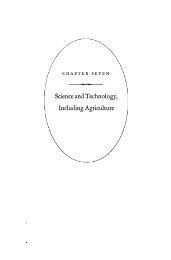Literature, Principally Belletristic - University of Tennessee, Knoxville
Literature, Principally Belletristic - University of Tennessee, Knoxville
Literature, Principally Belletristic - University of Tennessee, Knoxville
Create successful ePaper yourself
Turn your PDF publications into a flip-book with our unique Google optimized e-Paper software.
· <strong>Literature</strong>, <strong>Principally</strong> <strong>Belletristic</strong> .<br />
in book form in many library inventories, they were never as frequently<br />
listed as the T atler and Spectator collections. One <strong>of</strong> Cato's Letters on<br />
freedom <strong>of</strong> speech appeared in the South-Carolina Gazette as early as<br />
1736 and the same one twelve years later, with several other pieces from<br />
this source between and after 1736-1748. In fact, so many <strong>of</strong> these Whig<br />
essays were reprinted that Peter Timothy felt forced to declare that despite<br />
them he was not a Republican "unless Virtue and Truth be Republi<br />
-can." Abridged and whole selections were borrowed from the Grubstreet<br />
Journal, the Universal Magazine, the Reflector, the Gentleman's Magazine<br />
and the London Magazine, and essays were taken from the Chinese Spy,<br />
the Guardian, the Bee, the North Briton, and other serials or collections.201<br />
But in the South-Carolina Gazette as one might expect the essays most<br />
quoted, referred to, or presented as a whole were Addison and Steele's<br />
two series.<br />
The Maryland Gazette borrowed from most <strong>of</strong> the same periodicals,<br />
and from the General Magazine, the Westminster Journal, the Dublin<br />
Society's publications, the Remembrancer, the Traveller's Magazine, the<br />
Rambler, and a dozen others. The Gentleman's Magazine, the Westminster<br />
Journal, and the Universal Magazine were favorite sources from which<br />
to borrow essays for Jonas Green's Gazette and as already pointed out,<br />
many <strong>of</strong> William Parks' earlier "Plain-Dealer" pieces were straight from<br />
the British Free-Thinker.<br />
A study <strong>of</strong> the Virginia Gazette 1736-1766 reveals that Samuel Johnson's<br />
Rambler was the single most important source for borrowed essays<br />
in that newspaper, furnishing twenty-five. Next in frequency were borrowings<br />
from the Gentleman's and London Magazines and the London<br />
Gazetteer, with a number <strong>of</strong> others not too <strong>of</strong>ten used by the other southern<br />
newspapers. Altogether about 42 percent <strong>of</strong> the essays for these thirty years<br />
are reprints, a figure one could guess would hold for the Annapolis and<br />
Charleston newspapers. The aim <strong>of</strong> the Rambler was "to inculcate wisdom<br />
or piety," and its popularity may thus be in part explained, though in part<br />
also by the fact that these were much more nearly contemporary than the<br />
Addison and Steele prose pieces. The first Rambler appeared in 1750. The<br />
first to be reprinted in the Virginia Gazette was No. 67, on April 25, 175 I.<br />
Half a year or more later No. 65 and others appeared. On through 1752<br />
still others were carried, thus all within a year and a half. Their subjects<br />
and forms reveal a good deal about colonial tastes and what models were<br />
easily available for locally authored essays. The first printed was a dreamallegory<br />
about the role <strong>of</strong> hope in the life <strong>of</strong> man, the next an Eastern<br />
fable, and the third a disquisition on "complacency" with one's lot in life.<br />
Then there were more Eastern fables and moral essays on the advantages<br />
<strong>of</strong> mediocrity, the folly <strong>of</strong> desiring great wealth, the advisability <strong>of</strong> spending<br />
1449



